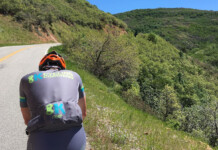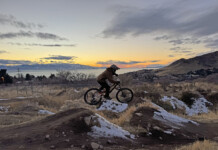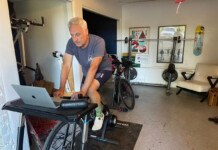By Mark Deterline
Pack-Dynamic
Many of us are drawn to cycling for social as well as fitness reasons. We’re not always able to chat with riding companions as much as we’d like due to the narrowness of roads, traffic, etc. However, just the fact that we’re traveling along on journeys short and long with people we like is sheer awesomeness.
Furthermore, cycling is an activity that binds us inextricably as joint participants, since we’re either “riding together” at the same pace side by side or benefitting from fellow riders’ slipstreams. Even in competitive events where the ultimate goal is to break free of the group, whether in a breakaway or a final sprint, staying with other riders is an inherent part of a sound strategy at least part of the time.
Cycling “packs” can be as small as two and big as any number of riders that shows up for a ride or race. That, along with constantly varying levels of fitness and physical freshness, means that no two rides will ever be the same!
At the same time, and as in most things, there are underlying principles and skills that enable us to navigate the resulting “chaos” successfully. Anticipating movements and leaving a margin of error are two of the most important things we can do to keep ourselves – and others – safe.
Big Picture
If you think about it, steering a bicycle is an endless succession of minute adjustments that keep us generally heading in a straight line or chosen arc of travel. While regulating speed consists of pedaling harder or softer, and even lightly applying the brakes when necessary.
Consider the challenge of holding our path of travel. If we fixate on the road or trail directly in front of us, we tend to over-adjust and counter-adjust to the point of undermining our goal. However, if we focus on a more expansive stretch of road or trail before us, it is easier to keep the bike guided in a straight line. The same applies to cornering: by focusing on where we want to go, we are better able to regulate our speed into the turn and hold a smooth line through it.
The same goes for pack riding, where we need to always be aware of our positioning within the group, as well as what is happening ahead, beside and – as far as we are able – behind us.
The Chains That Bind Us
A group of cyclists is an amorphous, moving mass; a composite collection of infinite movements and micro-adjustments, each with the potential of setting off a chain reaction throughout all or part of the pack. Managing such chaos requires not losing sight of the forest for the trees. It also requires a steady head and steady hands, as overreacting in the form of sudden reactionary movements or, worse, heavy braking, can have disastrous results.
Three of the most prevalent causes of accidents are:
– Overlapping of wheels, which especially in less experienced groups of riders, often represents an accident waiting to happen.
– Sudden, unexpected movements, especially swerving or sudden braking.
– Throwing one’s bike backward when coming out of the saddle to “stand” on the pedals to sprint, accelerate or find additional power when climbing, etc.
Since the first two are fairly straightforward, let’s concentrate on the third.
Smooth Operator
Coming out of the saddle is one of the most common actions cyclists execute for a number of different reasons. A rider may stand on the pedals to sprint or attack or to use different muscle groups when climbing or battling fatigue.
What many fail to realize is that, unless they are conscious of the effect such an action can have on the riders behind them, it can result in a dangerous chain reaction, sometimes resulting in a crash of one or more riders somewhere down the line.
Why? Because the act of coming out of the saddle can have the effect of slowing down the forward motion of a bike, if only for a fraction of a second. In fact, since the riders in a group are all traveling at approximately the same speed, the sudden slowing seems more like the bike is being thrown back into a following rider’s front wheel. This can be especially pronounced when climbing.
Not only can coming out of the saddle by throwing one’s bike backward in sudden and drastic fashion create a disturbance in the overall flow of a group, it can also prove inefficient. If a rider moves violently from an efficient rearward position in the saddle to an exaggerated forward position, it also means they can lose leverage on the pedals. Not to mention the potential for hitting knees against handlebars, especially on TT/triathlon bikes, which can prove disastrous.
Keeping the Pack Intact
Practice a smooth transition from seated riding to coming out of the saddle to stand on the pedals by keeping your bum positioned above yet only slightly forward of your seated position.
Experiment with the orientation of your legs, bum and hips to the axis of your pedaling rotation until you feel like you’re in a natural (i.e. not forced) position leveraging your body weight and the engagement of more muscles. The goal is to avoid losing momentum by throwing your bike rearward, virtually slamming your body in a forward position that may not actually gain you the additional leverage you are striving for in the first place.
Work on this smooth repositioning and you will likely notice that your climbing and sprinting improve.
Although the biggest winners will be your riding companions, whose fitness will determine whether or not they can follow your acceleration, as opposed to being thrown off course or crashed by a sudden rearward bike throw.
Mark Deterline and Dave Harward offer over thirty years of combined endurance training and competitive experience. Plan 7 Endurance Coaching provides professional coaching, biomechanics/bike fitting and physiological testing services for athletes of all levels. Reach them at: contact@plan7coaching.com.








